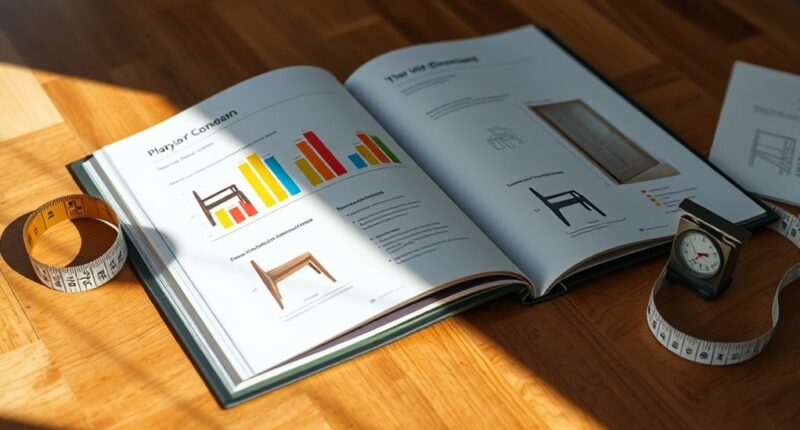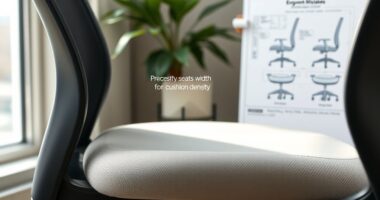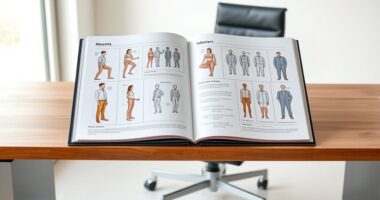To guarantee your chair fits through doorways and comfortably suits your space, start by knowing standard dimensions: seat heights of 16–18 inches, depths of 16–20 inches, and widths around 18 inches. Measure doorways and hallways carefully, including trim and multiple points for accuracy. Tilt or disassemble furniture if needed, and plan your route to avoid obstacles. Want detailed tips on steering tight spaces and optimizing your furniture setup? Keep exploring for the full guide.
Key Takeaways
- Know standard chair dimensions (seat height, depth, width, backrest height) for ergonomic fit and comfort.
- Measure doorways and hallways at multiple points to ensure furniture clearance during movement.
- Tilt, disassemble, or adjust chairs to navigate tight spaces and narrow passages safely.
- Match chair size and upholstery to space dimensions and decor for optimal fit and aesthetics.
- Plan routes carefully, use proper techniques, and allow extra time to prevent damage and facilitate smooth moving.
Standard Chair Dimensions: What You Need to Know
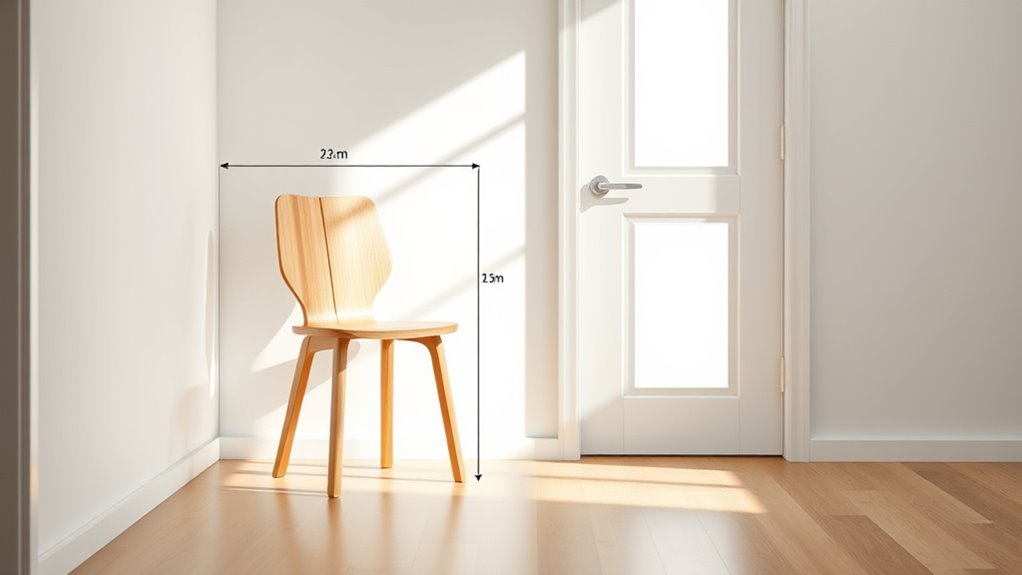
Have you ever wondered what the standard chair dimensions are for comfortable seating? Knowing these measurements helps guarantee ideal chair comfort and supports ergonomic design. Typically, seat height ranges from 16 to 18 inches from the floor, accommodating most users. The seat depth is usually around 16 to 20 inches, providing adequate thigh support without restricting movement. The seat width, about 18 inches, allows for comfortable sitting without feeling cramped. For lumbar support, the backrest height varies but should align with your lower back to promote good posture. These standard dimensions are designed to maximize comfort and ergonomic efficiency, making chairs suitable for a wide range of users. Understanding these measurements helps you select or design chairs that truly support healthy sitting habits. Proper chair dimensions are essential for creating a comfortable and supportive seating experience.
Measuring Doorways and Hallways for Chair Fit

To guarantee your chair fits through doorways and hallways, you need to accurately measure these spaces before making any purchases or modifications. Start by measuring the doorway width at its narrowest point, including any molding or trim. This ensures you have the maximum clearance needed for the chair to pass through easily. Next, measure the hallway length to confirm there’s enough space to maneuver the chair comfortably, especially if it’s large or bulky. Remember, it’s best to record these measurements in inches and double-check for consistency. Keep in mind that door frames can vary slightly, so measure multiple points if possible. Precise measurements help you select a chair that fits seamlessly and avoid surprises during delivery or installation. Incorporating industry trends can also help you choose designs that maximize space efficiency and ease of movement.
Tips for Navigating Tight Spaces With Large Chairs
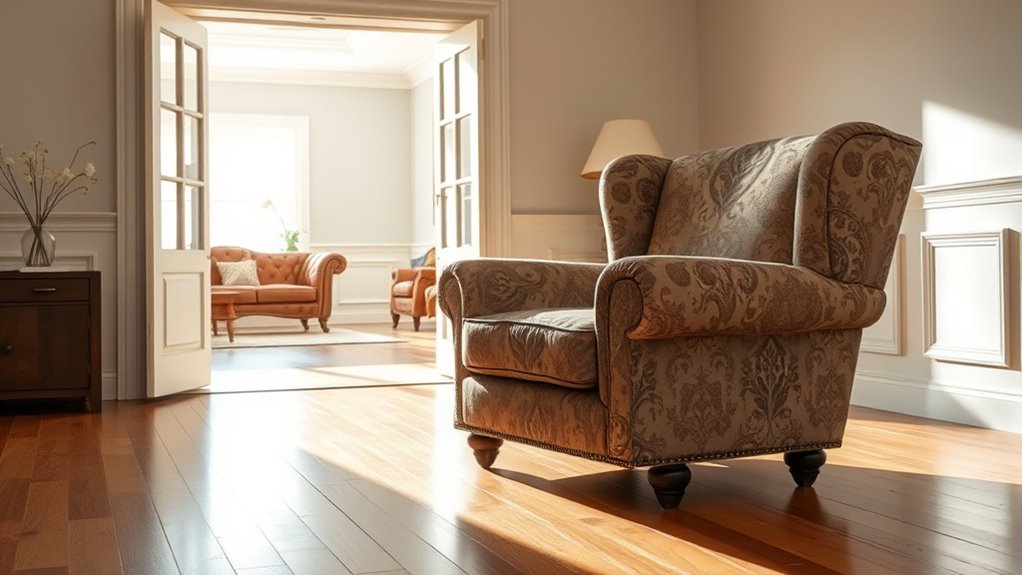
Moving through tight spaces with large chairs requires careful planning and strategic maneuvers. To avoid damaging furniture aesthetics and ensure ergonomic comfort, you should consider your approach. Tilt the chair slightly to reduce its width and pivot slowly, using your body to guide it through narrow openings. Keep the arms and legs close to the frame to maximize clearance. Being aware of furniture dimensions can help prevent mishaps during the process.
| Tip | Description |
|---|---|
| Measure gaps | Confirm doorways are wide enough before moving. |
| Use padding | Protect walls and furniture from scratches. |
| Plan your route | Visualize the path to avoid obstacles. |
| Tilt strategically | Reduce width without compromising stability. |
| Move gradually | Maintain control to prevent accidents. |
Best Practices for Moving Chairs Through Narrow Passages
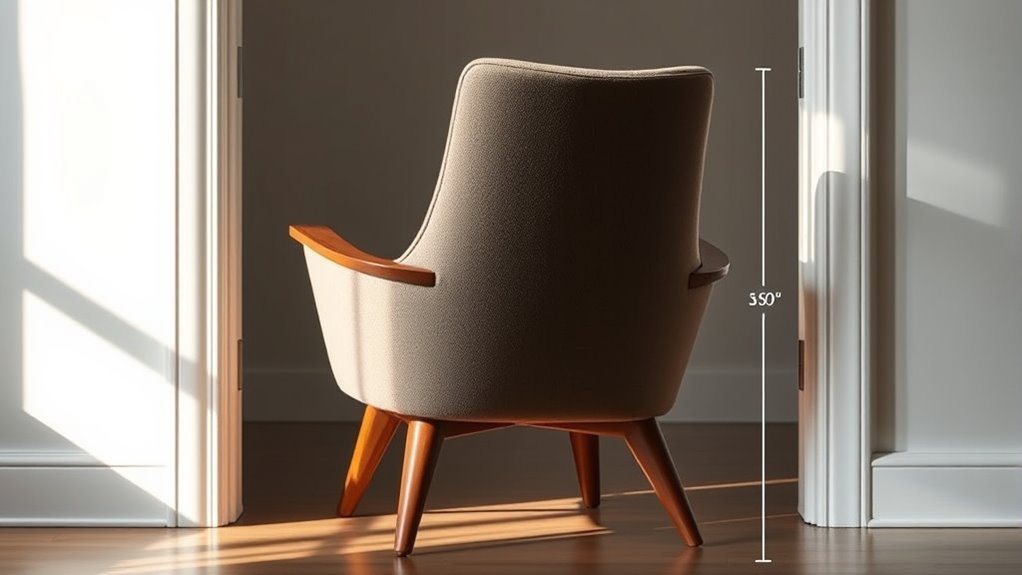
To move chairs through narrow passages, start by measuring doorways carefully to guarantee a smooth fit. When possible, tilt or fold the chair to reduce its width and make passage easier. Using proper lifting and moving techniques will help prevent damage and make the process safer for you. Additionally, understanding automation in business can provide insights into efficient strategies for handling large or cumbersome furniture items during relocation.
Measure Doorway Clearances Carefully
Careful measurement of doorway clearances is essential for maneuvering chairs through narrow passages without damage or difficulty. Start by measuring the doorway width at multiple points to account for any irregularities. Ensure the clearance height is sufficient for the tallest part of the chair, including any armrests or accessories. Don’t forget to check for obstructions like door handles, molding, or light fixtures that could interfere during passage. Record the smallest measurements, as these will determine if the chair can pass smoothly or if adjustments are necessary. Accurate measurements prevent surprises during moving. Remember, even a slight difference in doorway width or clearance height can make a big difference in safely steering tight spaces. Always double-check measurements before attempting to move your chair.
Tilt and Fold When Possible
When maneuvering through narrow doorways, tilting or folding your chair can make the process much easier. Many chairs feature a tilt mechanism or folding furniture design that allows you to reduce their width quickly. Folding chairs or those with a foldable backrest are especially helpful, as you can collapse them to fit through tight spaces. Using the tilt function, you can angle the chair to minimize its profile, easing passage without disassembly. Always check if your chair includes a tilt mechanism or foldable parts before attempting to move it through narrow openings. This simple adjustment can save you time and effort, preventing damage to the furniture or doorframe. Additionally, ergonomic considerations suggest that making your chair more compact by tilting or folding is a smart, effective way to navigate tight spaces easily.
Use Proper Moving Techniques
Using proper moving techniques is essential to safely and efficiently maneuver chairs through narrow passages. Begin by evaluating the chair’s weight and shape to determine the best lifting techniques. Always lift with your legs, not your back, to prevent injury. Coordinate with your team to ensure smooth communication and balanced movements. Clear the path of obstacles and plan the best angle for moving the chair. Keep the chair close to your body to maintain control and reduce strain. Use team coordination to lift and turn the chair in unison, avoiding sudden jerks or twisting motions. When navigating tight spots, tilt or fold the chair if possible, then carefully guide it through. Proper techniques help prevent damage and make the process safer for everyone involved. Additionally, understanding the mechanics of pinball machines can help in handling and moving vintage or complex furniture pieces related to arcade setups.
Selecting the Right Chair Size for Your Space
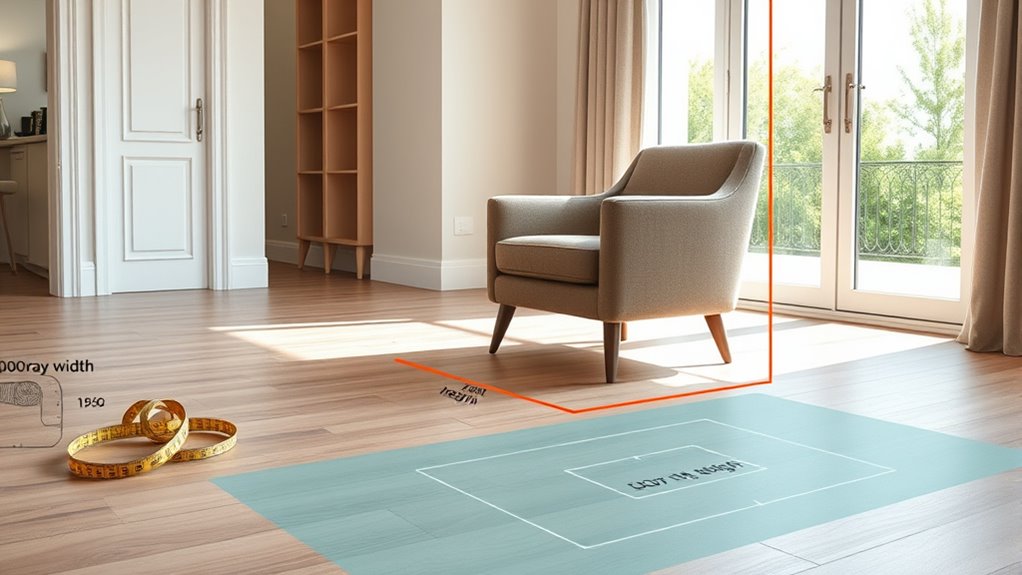
Choosing the right chair size is crucial to guarantee both comfort and efficient use of your space. First, measure your room to determine the maximum dimensions that will fit comfortably without overcrowding. Consider the upholstery choices that match your decor, ensuring the fabric and style complement your existing furniture. Color coordination is also key; selecting a chair in hues that blend or contrast effectively can enhance your room’s aesthetic. Keep in mind the scale of other furniture pieces to avoid overwhelming the space. If your room is small, opt for a sleek, compact chair that provides comfort without sacrificing openness. Conversely, in a larger room, you can choose a more substantial piece that serves as a focal point. Proper sizing ensures your space remains functional and visually appealing. Additionally, understanding personal development principles like goal setting and self-reflection can help you create a harmonious environment that supports your overall well-being.
Troubleshooting Common Moving and Fitting Challenges

Moving and fitting new furniture can present unexpected obstacles, even with careful planning. Narrow doorways, tight corners, or furniture with custom upholstery may cause fit issues. If a piece won’t pass through a doorway, consider removing legs or disassembling parts to reduce size. For furniture with ergonomic design, verify the dimensions align with your space, especially if it has bulky or curved features. Sometimes, a slight adjustment in angle or approach helps. If custom upholstery adds bulk, check if it’s removable or if the furniture can be temporarily reshaped. Always measure multiple entry points and plan your route ahead of time. Additionally, dog names can be a fun way to personalize your space and make moving in more enjoyable. With patience and flexibility, most challenges can be overcome without damaging your furniture or walls.
Frequently Asked Questions
How Can I Modify Chairs to Fit Irregular Doorway Sizes?
To fit chairs through irregular doorways, you can use custom chair adjustments like removing or folding arms and legs. Doorway modification techniques, such as widening or adding hinges, help create more space. Measure carefully and choose adjustable or collapsible chairs for flexibility. These strategies make it easier to navigate tight or oddly shaped doorways, ensuring your furniture fits comfortably without damage or hassle.
What Tools Are Best for Disassembling Large Chairs?
For chair disassembly, you need the right tools to make the process smooth. A screwdriver set with both Phillips and flat-head options is essential for removing screws, while a wrench or socket set helps with bolts. A utility knife can help with glued or tight joints. Always choose tools that match the fasteners on your chair to avoid damage. Proper tool selection guarantees safe, efficient chair disassembly, especially for large or complex pieces.
How Do Furniture Elevators Assist in Chair Moving?
Furniture elevators help you move chairs safely by easing the lifting process, reducing strain on your back. They allow you to position and lift the chair with minimal effort, following proper lifting techniques. Always observe safety precautions like securing the load and avoiding sudden movements. Using a furniture elevator minimizes injury risks and makes the move smoother, especially for heavy or bulky chairs, ensuring you handle the task efficiently and safely.
Are There Specific Materials That Make Chair Movement Easier?
Think of your chair as a ship steering narrow waters. Using a chair glide, along with lightweight materials, acts like a smooth current guiding it effortlessly through tight spaces. These materials reduce friction and weight, making movement easier and less strenuous. Opt for lightweight frames and add glides to your chair to guarantee it glides smoothly, turning a challenging task into a simple glide across calm waters.
How Do Building Codes Affect Chair and Doorway Dimensions?
Building codes directly influence your chair and doorway dimensions by requiring compliance with accessibility standards. You must verify doorways are at least 32 inches wide to accommodate wheelchairs and that chair designs meet safety and clearance regulations. By adhering to building code compliance, you create spaces that are safe and accessible for everyone, making sure your design aligns with legal requirements and promotes inclusivity.
Conclusion
Now that you know standard measurements and how to measure doorways, you’re ready to move with confidence. But remember, even the perfect fit can feel tight if you rush or overlook small details. It’s like choosing the right chair—looks aren’t everything, comfort matters too. So, plan carefully, move patiently, and don’t forget: a little extra space can make all the difference between a smooth move and a stressful struggle.
